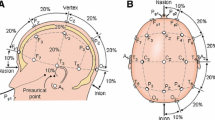Abstract
Electroencephalography (EEG), one of the most effective noninvasive methods for recording brain’s electrical activity, has widely been employed in the diagnosis of brain diseases for a few decades. Recently, the promising biometric potential of EEG, for developing person identification and authentication systems, has also been explored. This paper presents the superior performance of power spectral density (PSD) features of gamma band (30–50 Hz) in biometric authentication, compared to delta, theta, alpha and beta band of EEG signals during rest state. The proposed authentication technique based on simple cross-correlation values of PSD features extracted from 19 EEG channels during eyes closed and eyes open rest state conditions among 109 subjects offers an equal error rate (EER) of 0.0196 which is better than the state-of-the-art method employing eigenvector centrality features extracted from gamma band of 64 EEG channels of the same dataset. The obtained results are promising, but further investigation is essential for exploring the subject-specific neural dynamics and stability of gamma waves and for optimizing the results.











Similar content being viewed by others
References
M. Abo-Zahhad, S.M. Ahmed, S.N. Abbas, inter-subject variance of gammaband PSD compared to the intra-subject variability. IET Biom. 4, 179–190 (2015)
B.C. Armstrong, M.V. Ruiz-Blondet, N. Khalifian, K.J. Kurtz, Z. Jin, S. Laszlo, Brainprint: assessing the uniqueness, collectability, and permanence of a novel method for ERP biometrics. Neurocomputing 166, 59–67 (2015)
P. Campisi, D. La Rocca, Brain waves for automatic biometric-based user recognition. IEEE Trans. Inf. Forensics Secur. 9, 782–800 (2014)
A. Crobe, M. Demuru, L. Didaci, G.L. Marcialis, M. Fraschini, Minimum spanning tree and k-core decomposition as measure of subject-specific EEG traits. Biomed. Phys. Eng. Express 2, 017001 (2016)
M. DelPozo-Banos, C.M. Travieso, C.T. Weidemann, J.B. Alonso, EEG biometric identification: a thorough exploration of the time-frequency domain. J. Neural Eng. 12(5), 056019 (2015)
M. Fraschini, A. Hillebrand, M. Demuru, L. Didaci, G.L. Marcialis, An EEG-based biometric system using eigenvector centrality in resting state brain networks. IEEE Signal Process. Lett. 22(6), 666–670 (2015)
A.L. Goldberger, L.A.N.L. Amaral, J. Glass, M. Hausdorff, P.C. Ivanov, R.G. Mark, J.E. Mietus, G.B. Moody, C.K. Peng, PhysioBank, PhysioToolkit, and PhysioNet: components of a new research resource for complex physiologic signals, Circulation 101(23), e215–e220 (2004)
http://www.physionet.org/pn4/eegmmidb/. Date of retrieval: 26-11-2015
H. Imtiaz, S.A. Fattah, A DCT-based local dominant feature extraction algorithm for palm-print recognition. Circuits Syst. Signal Process. 32, 1179–1204 (2013)
D. La Rocca, P. Campisi, B. Vegso, P. Cserti, G. Kozmann, F. Babiloni, F. De Vico Fallani, Human brain distinctiveness based on EEG spectral coherence connectivity. IEEE Trans. Biomed. Eng. 61, 2406–2412 (2014)
E. Maiorana, D. La Rocca, P. Campisi, On the permanence of EEG signals for biometric recognition. IEEE Trans. Inf. Forensics Secur. 11, 163–175 (2016)
S. Marcel, J.D.R. Millán, Person authentication using brainwaves (EEG) and maximum a posteriori model adaptation. IEEE Trans. Pattern Anal. Mach. Intell. 29(4), 743–748 (2006)
K.A. Nixon, V. Aimale, R.K. Rowe, Spoof detection schemes, in Handbook of biometrics, ed. by A.K. Jain, P. Flynn, A.A. Ross (Springer, New York, 2008), pp. 403–423
S. Prabhakar, S. Pankanti, A.K. Jain, Biometric recognition: security and privacy concerns. IEEE Secur. Priv. 2, 33–42 (2003)
G. Schalk, D.J. McFarland, T. Hinterberger, N. Birbaumer, J.R. Wolpaw, BCI2000: a general-purpose brain–computer interface (BCI) system. IEEE Trans. Biomed. Eng. 51, 1034–1043 (2004)
P. Welch, The use of fast Fourier transforms for the estimation of power spectra: a method based on time averaging over short modified periodograms. IEEE Trans. Audio Electroacoust. 15, 70–73 (1967)
Author information
Authors and Affiliations
Corresponding author
Rights and permissions
About this article
Cite this article
Thomas, K.P., Vinod, A.P. EEG-Based Biometric Authentication Using Gamma Band Power During Rest State. Circuits Syst Signal Process 37, 277–289 (2018). https://doi.org/10.1007/s00034-017-0551-4
Received:
Revised:
Accepted:
Published:
Issue Date:
DOI: https://doi.org/10.1007/s00034-017-0551-4




